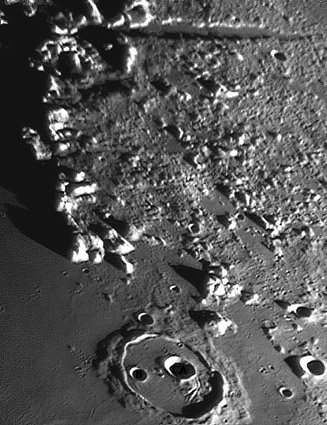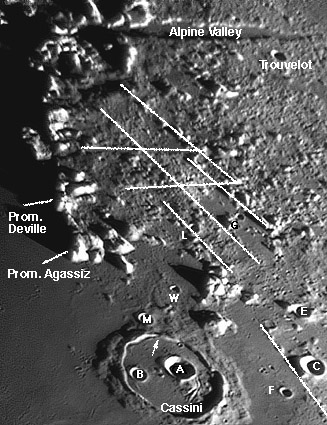Difference between revisions of "June 14, 2004"
| (4 intermediate revisions by the same user not shown) | |||
| Line 1: | Line 1: | ||
__NOTOC__ | __NOTOC__ | ||
=Cassini North= | =Cassini North= | ||
| + | <!-- Start of content --> | ||
<table width="640" border="0" align="center" cellpadding="4" cellspacing="2"> | <table width="640" border="0" align="center" cellpadding="4" cellspacing="2"> | ||
<tr> | <tr> | ||
| Line 28: | Line 29: | ||
<p class="story" align="left"><b>Related Links:</b><br> | <p class="story" align="left"><b>Related Links:</b><br> | ||
[http://www.lpi.usra.edu/meetings/LPSC99/pdf/1348.pdf Deposits of Imbrium Basin] (PDF)<br> | [http://www.lpi.usra.edu/meetings/LPSC99/pdf/1348.pdf Deposits of Imbrium Basin] (PDF)<br> | ||
| − | [ | + | [http://www.lpi.usra.edu/research/lunar_orbiter/images/img/iv_110_h2.jpg Cassini Crater on the Moon (LO IV)]<br> |
[http://www.msss.com/moc_gallery/e13_e18/images/E18/E1800638.html Cassini Crater on Mars (impact)]<br> | [http://www.msss.com/moc_gallery/e13_e18/images/E18/E1800638.html Cassini Crater on Mars (impact)]<br> | ||
[http://homepage2.nifty.com/gradation/3dcg/vistapro2/mars/cassini_crater.html Cassini Crater in Arabia (probably not impact)] | [http://homepage2.nifty.com/gradation/3dcg/vistapro2/mars/cassini_crater.html Cassini Crater in Arabia (probably not impact)] | ||
</p> | </p> | ||
| − | <p | + | <p><b>Yesterday's LPOD:</b> [[June 13, 2004|Mercy, Mersenius!]] </p> |
| + | <p><b>Tomorrow's LPOD:</b> [[June 15, 2004|Magnificent Greek Eclipse!]] </p> | ||
</tr> | </tr> | ||
</table> | </table> | ||
| Line 39: | Line 41: | ||
<p align="center" class="main_titles"><b>Author & Editor:</b><br> | <p align="center" class="main_titles"><b>Author & Editor:</b><br> | ||
[mailto:tychocrater@yahoo.com Charles A. Wood]</p> | [mailto:tychocrater@yahoo.com Charles A. Wood]</p> | ||
| − | < | + | <!-- Cleanup of credits --> |
| − | + | <!-- Cleanup of credits --> | |
| − | < | + | <!-- Cleanup of credits --> |
| − | + | <!-- Cleanup of credits --> | |
| − | < | + | <!-- Cleanup of credits --> |
| − | + | <!-- Cleanup of credits --> | |
| + | <!-- Cleanup of credits --> | ||
<p> </p> | <p> </p> | ||
| − | + | <!-- End of content --> | |
| − | + | {{wiki/ArticleFooter}} | |
| − | |||
| − | |||
| − | <!-- | ||
| − | |||
| − | |||
| − | |||
| − | |||
| − | |||
| − | |||
| − | |||
Latest revision as of 11:23, 6 June 2015
Cassini North
Cassini North Cassini is an unusual looking crater. I think its because it is surrounded by Imbrium lavas so there is an abrupt boundary with its near rim deposits, and because it is filled with lava nearly to its rim. Cassini is a more extreme version of Archimedes. The interior of Cassini (diameter 57 km, depth 1.3 km) has peculiar hills and coarse rilles just inside its eastern rim - they don't look like remnants of a terraced wall. Along its northwest inner wall a weird little worm-like feature goes from the floor over the rim. The Lunar Orbiter IV view doesn't clarify the origin of this worm. The area north of Cassini is the lunar Alps with a front of massive mountainous blocks (massifs) and much smaller scattered hills behind. The Alps are probably crustal rocks uplifted by the Imbrium basin formation, and the smaller hills are ejecta fallback from the event. There was more than just fallback going on though. On the mouseover you will see various sets of white lines that highlight linear features in the Alpes Formation (as the US Geological Survey calls it). Some lines are radial to the Imbrium basin - they probably represent crustal fractures as the pre-existing rocks were being domed up in response to the impact "explosion." Other lines, nearly at right angles to the radial set, define a linear trough that has subsided - it is filled with lavas in places. I wonder if this is equivalent to a terrace in an impact crater? Look around this marvelous image by Tom Leech to find other details we don't fully understand - it's not that they are mysteries, rather the cratering process is very complicated; we need to examine this stuff on the ground! Technical Details: Originally posted April 17, 2004 Related Links: Yesterday's LPOD: Mercy, Mersenius! Tomorrow's LPOD: Magnificent Greek Eclipse! |
Author & Editor:
Charles A. Wood
COMMENTS?
Register, Log in, and join in the comments.





